Recent Fire Damage Posts
The Benefits of Professional Upholstery Cleaning After a Fire
4/17/2024 (Permalink)
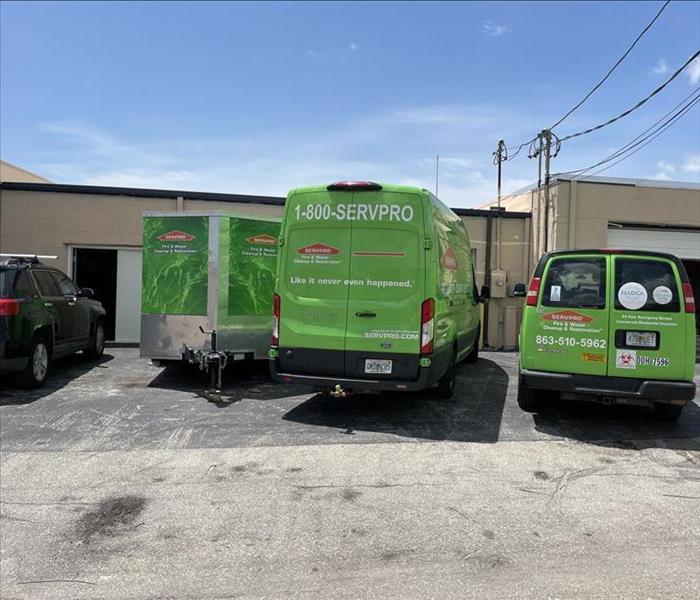 In this blog, we will explore the benefits of professional upholstery cleaning after a fire, highlighting the importance of material cleaning.
In this blog, we will explore the benefits of professional upholstery cleaning after a fire, highlighting the importance of material cleaning.
After a fire incident, the damage caused by smoke and soot extends beyond the structure itself. Upholstered furniture and fabrics can suffer significant smoke and fire damage, resulting in unpleasant odors, stains, and soot particles deeply embedded within the materials. Professional upholstery cleaning services are crucial in restoring fire-damaged upholstery and ensuring its longevity. In this blog, we will explore the benefits of professional upholstery cleaning after a fire, highlighting the importance of material cleaning and contents restoration in comprehensive fire damage restoration and remediation efforts.
Efficient Smoke and Soot Removal
Professional upholstery cleaning after a fire ensures thorough smoke and soot removal from your furniture. Trained technicians use specialized equipment, such as high-powered vacuums and industrial-grade cleaning agents, to effectively extract and eliminate smoke particles, soot, and residue from the fabric. This meticulous cleaning process minimizes the risk of lingering odors and prevents further damage caused by corrosive soot particles.
Restoration of Upholstery Appearance
Fire and smoke damage can leave upholstery looking dull, discolored, and stained. Professional upholstery cleaning techniques, such as hot water extraction or dry cleaning, help restore the appearance of the fabric by removing soot, stains, and discoloration. With the right cleaning methods and products, technicians can revive the color, texture, and overall aesthetics of the upholstery, making it look fresh and clean once again.
Elimination of Lingering Odors
One of the most significant benefits of professional upholstery cleaning after a fire is the elimination of lingering smoke odors from the fabric. Smoke particles tend to embed themselves deep within the upholstered material, leading to persistent and unpleasant smells. Professional cleaning methods, such as steam cleaning and deodorization, effectively remove these odor-causing particles, leaving the upholstery smelling fresh and free from any reminders of the fire incident.
Prevention of Further Damage
When left unaddressed, smoke residues and soot particles can further damage upholstery over time. The corrosive nature of these particles can cause discoloration, staining, and even deterioration of the fabric fibers. By professionally cleaning the upholstery promptly after a fire, you prevent the risk of progressive damage, extending the lifespan of the furniture and protecting your investment.
Restoration of Contents
Professional upholstery cleaning is an essential component of comprehensive contents restoration after fires. Furniture and upholstery are valuable assets, and restoring them can significantly reduce replacement costs. By investing in professional cleaning services, you can salvage fire-damaged upholstery, bringing it back to its pre-fire condition and preserving cherished items with sentimental value.
Expertise and Access to Specialized Equipment
Professional upholstery cleaning services bring expertise and industry knowledge to the restoration process. Trained technicians have the experience to handle various upholstery materials, identifying the most effective cleaning methods and products for optimal results. Additionally, they have access to specialized cleaning equipment and tools that are not readily available to homeowners. Their expertise paired with advanced equipment ensures thorough and efficient cleaning, enhancing the overall success of fire damage restoration efforts.
Professional upholstery cleaning plays a crucial role in fire damage restoration and remediation. By efficiently removing smoke and soot particles, restoring the appearance of upholstery, eliminating lingering odors, and preventing further damage, professional cleaning services offer invaluable benefits. When faced with fire-damaged upholstery, it is essential to engage the services of professional fire damage restoration experts, such as SERVPRO®, who possess the knowledge, expertise, and specialized equipment needed for effective material cleaning and contents restoration. Let the professionals handle the restoration process, and you can have confidence in the successful recovery of your upholstered furniture after a fire.
The Importance of Air Duct Cleaning After a Fire
12/16/2023 (Permalink)
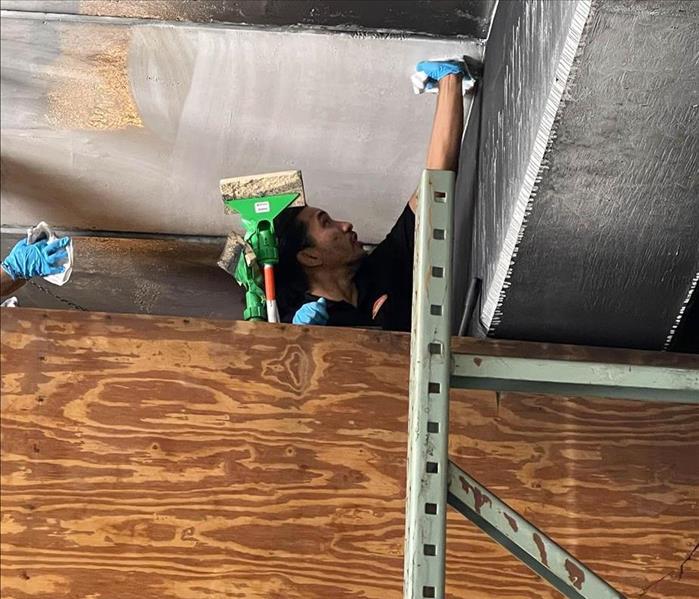 Fires produce a cocktail of harmful elements, including smoke and soot.
Fires produce a cocktail of harmful elements, including smoke and soot.
Experiencing a fire accident is a traumatic event that can leave your home or business with more than just visible damage. While the immediate focus is on addressing fire damage, one aspect that's often overlooked is the impact on your indoor air quality. In this blog, we will delve into why it's crucial to clean your air ducts after a fire accident and how this step can significantly contribute to your property's restoration and the well-being of its occupants.
1. Smoke and Soot Residue
Fires produce a cocktail of harmful elements, including smoke and soot. These particulates can infiltrate your HVAC system, settling in the air ducts and compromising indoor air quality. Neglecting to clean the air ducts can result in ongoing exposure to these harmful substances, potentially leading to health issues.
2. Odor Removal
One of the most noticeable and persistent effects of a fire accident is the lingering odor of smoke. This odor can be challenging to eliminate, especially when it has permeated your air ducts. Cleaning your air ducts is a critical step in removing these odors, making your indoor environment more pleasant and comfortable.
3. Health and Safety
The smoke and soot particles released during a fire contain various harmful substances, including carbon monoxide, volatile organic compounds (VOCs), and other toxic materials. If these contaminants are left in your air ducts, they can continue to circulate in your indoor air, posing risks to occupants. Regular air duct cleaning is essential for maintaining a healthy indoor environment.
4. Preventing Resettlement of Contaminants
Smoke and soot particles are highly adhesive, which means they can easily settle on surfaces, including those within your air ducts. If left unaddressed, these contaminants can become a reservoir for further contamination. Cleaning your air ducts not only removes existing pollutants but also prevents their resettlement.
5. Efficiency and Longevity of HVAC System
A clean HVAC system operates more efficiently and has a longer lifespan. When smoke and soot particles accumulate in the system, it forces it to work harder to maintain temperature and air quality. This can result in increased energy consumption and potential breakdowns. Air duct cleaning helps improve the efficiency and longevity of your HVAC system.
6. Comprehensive Restoration
Cleaning your air ducts is a crucial component of comprehensive fire damage restoration. By addressing all aspects of fire damage, including air duct cleaning, you ensure that your property is fully restored to its pre-fire condition.
In conclusion, cleaning your air ducts after a fire accident is not just an aesthetic choice; it's a critical step in ensuring the safety, health, and comfort of your indoor environment. The lingering effects of smoke and soot, from odors to contaminants, can persist if not addressed. Professional air duct cleaning services, like those offered by SERVPRO® of NE Hillsborough/Plant City, are essential for a complete and thorough fire damage restoration process. Prioritizing air duct cleaning contributes to a healthier and safer indoor environment for you and your loved ones.
The Commercial Fire Cleanup Process: Restoring Your Business after a Devastating Fire
8/30/2023 (Permalink)
 Remember, hiring a professional fire restoration company is essential for a successful commercial fire cleanup.
Remember, hiring a professional fire restoration company is essential for a successful commercial fire cleanup.
A fire can be devastating for any business, causing significant damage and disruption. After the flames have been extinguished, it's essential to start the commercial fire cleanup process as soon as possible. This process involves several critical steps to assess the damage, clean up the debris, and restore your business to its pre-fire condition. In this blog post, we will discuss the essential steps involved in commercial fire cleanup and why it's important to hire professionals for this task.
Step 1: Assessment and Safety Measures
The first step in commercial fire cleanup is to assess the extent of the damage. A professional fire restoration company will conduct a thorough inspection to determine the areas affected by the fire, smoke, and soot. They will also evaluate the structural integrity of the building and identify any safety hazards.
During this assessment, safety measures are implemented to protect workers and prevent further damage. These measures may include securing the building, boarding up windows and doors, and setting up temporary fencing.
Step 2: Debris Removal
Once the assessment is complete, the next step is to remove debris. This involves removing damaged materials, such as walls, ceiling tiles, furniture, and equipment. Debris removal is a crucial step as it allows for easier access to the affected areas and prevents further contamination.
Professional fire cleanup teams are skilled in handling debris removal safely and efficiently. They use specialized equipment like dumpsters and heavy-duty machinery to haul away the debris. Proper disposal is also essential to comply with regulations and minimize environmental impact.
Step 3: Smoke and Soot Cleaning
Smoke and soot can cause extensive damage and leave behind lingering odors. The third step in the commercial fire cleanup process involves cleaning and removing smoke and soot residues from surfaces, including walls, ceilings, floors, and equipment.
Experienced professionals use specialized techniques and equipment to effectively clean and restore affected areas. This may involve using chemical cleaners, high-powered vacuums, and thermal fogging to neutralize odors and remove smoke and soot particles.
Step 4: Water and Fire Damage Restoration
Firefighting efforts often result in water damage. The cleanup process includes water extraction and drying to prevent secondary damage, such as mold growth. Fire-damaged areas are then repaired and restored, including structural repairs, electrical and plumbing work, and repainting.
Throughout the commercial fire cleanup process, it is essential to document all the damaged areas, items, and the restoration process itself. This documentation is vital for insurance claims and can help ensure that you receive fair compensation for the damages. Professional restoration companies often work closely with insurance providers to streamline the claims process. They can provide the necessary documentation and assist with filing the insurance claim accurately.
A commercial fire can be a devastating event for any business. However, with the right professionals and a systematic fire cleanup process in place, a business can recover and rebuild. By following the necessary steps, from assessment to documentation, you can restore your business to its former glory.
Remember, hiring a professional fire restoration company is essential for a successful commercial fire cleanup. They have the expertise, equipment, and knowledge to handle the restoration process safely and efficiently, allowing you to focus on getting your business back on track.
Dealing with Accidental Fire Sprinkler Activation: Quick Steps for Effective Response
7/17/2023 (Permalink)
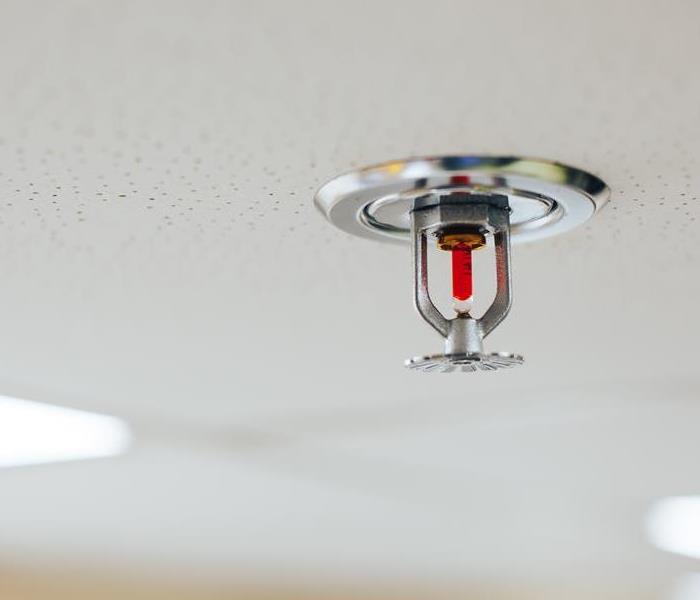 Having fire protection is always top priority in your business.
Having fire protection is always top priority in your business.
Fire sprinkler systems are crucial for protecting lives and property in the event of a fire. However, there may be instances when sprinklers are accidentally triggered, causing water damage and potential disruption. If you find yourself in a situation where fire sprinklers go off accidentally, it's important to take immediate action to mitigate the damage and ensure safety. In this blog post, we will outline the necessary steps to follow if the fire sprinklers are activated unintentionally, helping you navigate through the situation effectively.
Stay Calm and Assess the Situation
The first and most crucial step is to stay calm and assess the situation. Take a moment to understand the extent of the accidental activation and evaluate any potential hazards or risks. Assess whether the sprinklers have been triggered in a single area or throughout the building.
Locate the Water Shutoff Valve
Locate the main water shutoff valve for the fire sprinkler system. It is typically found near the sprinkler riser or in a designated control room. Shutting off the water supply will help minimize further water discharge and damage. Turn the valve clockwise to close it fully.
Contact the Fire Department and Building Management
Notify the fire department and building management immediately about the accidental activation of the fire sprinklers. Provide them with accurate information about the situation and follow any instructions they provide.
Document the Incident
Take photos or videos of the affected areas to document the extent of the damage caused by the accidental sprinkler activation. This documentation may be necessary for insurance claims or discussions with building management.
Remove Excess Water
If possible, use buckets, mops, or towels to start removing excess water from the affected areas. Promptly dry any sensitive or valuable items to prevent further damage. Open windows or use fans to facilitate air circulation and aid in the drying process.
Seek Professional Assistance
Contact a reputable water damage restoration company with experience in handling water emergencies. They can assess the situation, provide professional advice, and assist in the cleanup and restoration process. Their expertise will help ensure proper water extraction, drying, and mitigating any potential mold growth.
Communicate with Insurance Provider
Notify your insurance provider about the accidental activation of the fire sprinklers. Provide them with all relevant information, including photos and documentation of the incident. Consult with them on the necessary steps to file a claim and seek coverage for the damages incurred.
While accidental activation of fire sprinklers can be disruptive and cause water damage, it is crucial to stay calm and take immediate action. By promptly locating and shutting off the water supply, contacting the necessary authorities, documenting the incident, removing excess water, seeking professional assistance, and communicating with your insurance provider, you can effectively manage the situation and minimize the impact of the accidental sprinkler activation. Remember, safety should always be the top priority, and professional assistance is invaluable in restoring your property to its pre-incident condition.
Protecting Your Business: Understanding What a Commercial Property Insurance Policy Covers
4/5/2023 (Permalink)
 Commercial insurance is essential to have for businesses of all sizes.
Commercial insurance is essential to have for businesses of all sizes.
Commercial property insurance, also known as business property insurance, is a type of policy that protects businesses and organizations from financial loss due to damage or loss of their property. Commercial property insurance policies can vary depending on the type of business, the location, and the specific coverage needs. However, there are some common types of coverage that are typically included in a commercial property insurance policy.
Property Damage
Property damage coverage is designed to protect your business against damage to your property, including your building, office equipment, and inventory. The policy will cover the cost of repairs or replacement of damaged property due to fire, theft, vandalism, or natural disasters such as floods, hurricanes, and earthquakes.
Business Interruption
Business interruption coverage provides financial protection for businesses that are unable to operate due to property damage. This coverage can help cover lost revenue, payroll, and other expenses during the time when the business is closed for repairs.
Liability Coverage
Liability coverage is designed to protect your business in the event of lawsuits or claims against your business. This type of coverage will pay for legal defense costs, settlements, and judgments if a customer or third party is injured on your property or if your business causes property damage or personal injury.
Equipment Breakdown
Equipment breakdown coverage provides financial protection for businesses that rely on machinery and equipment. This coverage can help cover the cost of repairs or replacement of damaged equipment due to mechanical failure, electrical surges, or other causes.
Commercial Auto Insurance
Commercial auto insurance is a type of coverage that is designed for businesses that use vehicles for business purposes. This policy can cover damage to your vehicles and liability in the event of accidents.
Flood Insurance
Flood insurance is a separate policy that is designed to protect businesses from damage caused by flooding. Commercial property insurance policies typically do not include coverage for flooding, so it is important to consider purchasing flood insurance if your business is located in an area that is at risk of flooding.
In conclusion, commercial property insurance is essential for businesses of all sizes and types. It provides financial protection for property damage, liability claims, equipment breakdown, and other risks that can impact your business. It is important to review your coverage needs carefully with your insurance provider to ensure that your policy provides adequate protection for your business. With the right coverage, you can have peace of mind knowing that your business is protected in the event of unexpected losses or damages.
How to Choose the Right Smoke Detector for Your Home
2/8/2023 (Permalink)
 No matter what type of smoke detector you choose, it is crucial to have one in each room of your home.
No matter what type of smoke detector you choose, it is crucial to have one in each room of your home.
Fire is one of the leading causes of death in the country. It’s estimated that more than 40,000 people die each year from fires and that three out of every four fire deaths occur in homes. To protect your home and loved ones from these tragic statistics, it’s imperative to have a smoke detector. But don’t just settle for any smoke detector—make sure you choose one that will give you ample warning if there is ever an emergency at home.
Types of Smoke Detectors
There are two common types of smoke detectors: ionization detectors and photoelectric detectors.
Ionization smoke detectors use an ionization chamber to detect smoke particles. Photoelectric sensors work in exactly the same way as ionization alarms, except instead of using wires to sense smoke particles, they use light beams that pass-through phototubes.
Ionization detectors
Ionization smoke detectors are the least expensive choice and are typically installed in new homes. They’re sensitive to fast-moving fires, which means they can be triggered by flaming fires and large, smoky fires.
Ionization detectors work by detecting the atoms produced when a fire occurs—the atoms that make up smoke from flames and heat. These detectors rely on the detection of particles in the air (ions).
Ionization smoke detectors are the most common type of detector, and for good reason: they're less expensive than photoelectric detectors and can be installed in a period as short as five minutes. However, ionization detectors have a few downsides. One downside is since they're so sensitive to fast fires that produce lots of smoke, they are prone to false alarms.
Photoelectric detectors
Photoelectric detectors are more sensitive to smaller particles and are better at detecting smoldering fires. They’re not as good at detecting fast-moving fires because the smoke particles in those fires move too quickly for the photoelectric sensor to react.
Photoelectric detectors work by using a light beam as an optical trigger, which is aimed at a photocell on the front of the unit. When light enters this cell, it triggers an alarm if smoke reaches it before you do—but only if there is no visible flame present in your home!
This sensitivity makes photoelectric detectors ideal for detecting smoldering fires before they become fully developed blazes. The speed and temperature at which these fires spread can be detected by an early warning system like this one, so you can take action even before it's too late.
The importance of having a smoke detector in your home
Smoke detectors are a must in any home. They can help save lives and alert you to a fire before it gets out of hand. Smoke detectors should be installed in every room of your house, including the basement and garage.
A smoke detector is a lifesaver, but these devices are often misunderstood because they are easily forgotten about until an emergency situation arises. To avoid this problem, it's important that you know exactly how a smoke detector works so that you can install them safely and effectively in all areas of your home. A professionally-installed smoke detector is easy to find at most hardware stores or big box retailers like Walmart or Home Depot; however, there may also be local companies that offer installation services as well.
No matter what type of smoke detector you choose, it is crucial to have one in each room of your home. We hope this article has given you the information needed to make an informed decision about which is best for your home.
Quick Guide to Residential Fire Extinguishers
8/24/2022 (Permalink)
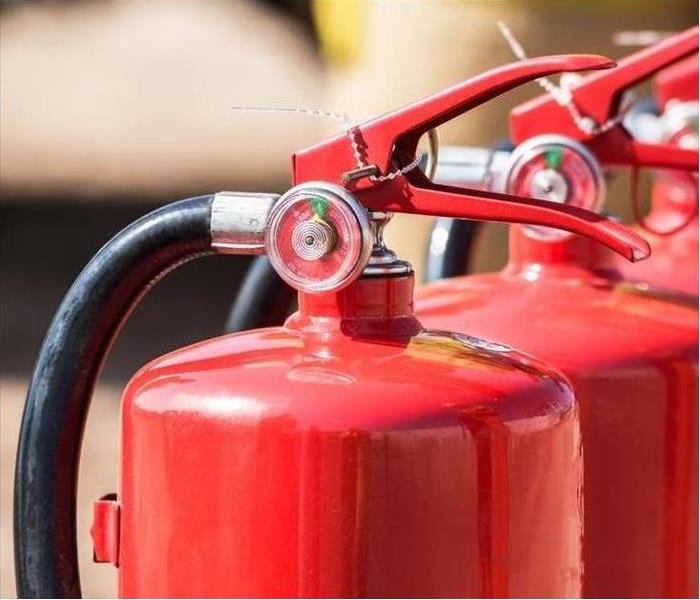 To make sure you get a fire extinguisher that will operate in your home, read the label carefully.
To make sure you get a fire extinguisher that will operate in your home, read the label carefully.
Extinguishers For The Home
Having a fire extinguisher in your home in Valrico, FL can help you increase your chances of escaping from a fire. With so many products on the market, it can be hard to know which one is right for you. Use this guide and talk with a residential fire cleanup expert to figure out which extinguisher you should stock.
Size
This fire preparedness tool comes in a variety of sizes. The size you want to get depends on where in the house you want to keep it.
- 2-pound: This small extinguisher is perfect for on the go. You can keep it in the trunk of your car to help prepare you for any situation. Some small models come with mounting hardware, so you can keep it in one place.
- 5-pound: This rechargeable model works well in fire-hazard areas in the home. Consider keeping it near your kitchen or laundry room, so it's easily accessible.
- 10-pound: This larger fire extinguisher is ideal for parts of the home that are left unattended for periods of time. The size means there's more fire suppressant chemicals, which can help dampen a fire that went unnoticed for a bit. Keep this size in a garage, shed or workshop.
As you consider the size of your extinguisher, you also need to think about your personal capabilities. If you would struggle to lift and use a 10-pound extinguisher, it might not be the right option for you.
Classification
You also have to think about the classification of the extinguisher. Residential products come in three classes: A, B and C. The A classification means the suppressant will work well on trash, wood and paper. B means the extinguisher can help put out a home fire caused by grease or liquids. C usually means it's suited for electrical fires.
Read the label of your fire extinguisher closely to make sure you have a unit that can work well in your home. Consider both size and classification before you buy your next fire dampening tool.
What To Know About Rental Insurance Fire Damage Coverage
4/18/2022 (Permalink)
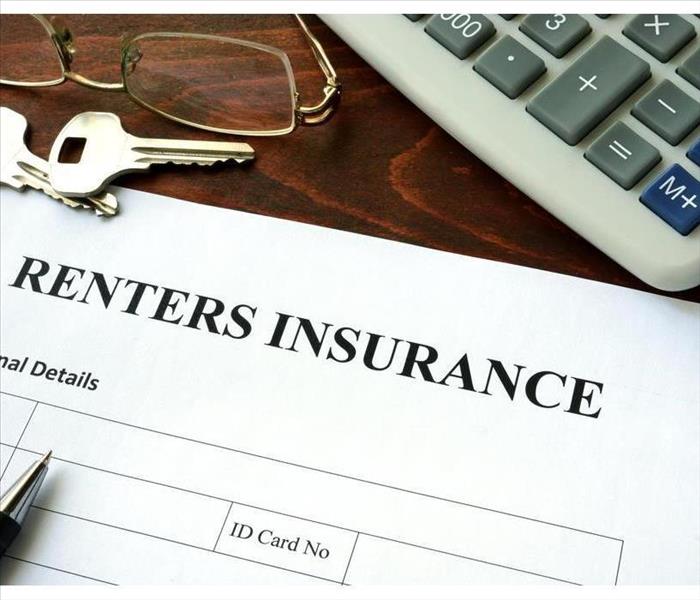 Renters insurance does pay for damage to your personal property after a fire.
Renters insurance does pay for damage to your personal property after a fire.
What You Should Know About Renter's Insurance Protection Against Fire
Before you moved into your Valrico,FL, apartment, you probably purchased renters insurance. You may be wondering exactly what that insurance does and does not cover. Most rental policies can be applied to various types of emergencies, including:
- Storms
- Theft
- Accidental overflows of water
Fire is another common peril covered by insurance. However, there are some limits to this coverage. Here are some factors that determine the payout you will receive from your insurer.
Structural Versus Personal Property Damage
The structure of your apartment building is considered the landlord's responsibility, not the tenant's. Any fire damage to the walls, floor or roof should be covered by the property owner's insurance. Your renters insurance, meanwhile, should pay for harm to your personal property within the apartment. You can use this insurance money to replace certain items or to hire fire restoration professionals who can repair your belongings.
Even if the fire resulted from your negligence, the damage should still be covered by insurance. The insurer could deny your claim if it determines that you criminally set the blaze, however.
Replacement Cost Versus Actual Cash Value
Check your policy to see if it includes replacement cost coverage. If not, consider purchasing this inexpensive endorsement. This way, if any of your valuables do need to be discarded following a fire, your insurance will give you enough money to purchase new items.
Without this endorsement, the insurer may only reimburse you for the actual cash value of those destroyed belongings. This amount is likely insufficient to purchase replacements.
Loss of Use
Your rental policy may additionally include loss of use coverage. This helps pay for any temporary living expenses you incur, such as hotel payments, while your apartment is being restored.
Renters insurance does pay for damage to your personal property after a fire. To ensure you can actually replace any items that are destroyed in the blaze, you should purchase a replacement cost endorsement . Your policy may also provide loss of use coverage if you have to temporarily move out of your apartment.
Fire Remediation: From Start to Finish
3/1/2022 (Permalink)
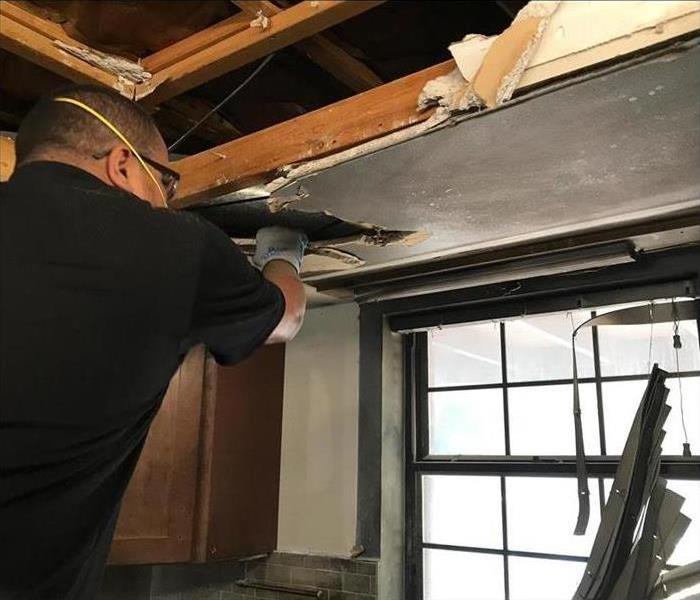 SERVPRO of NE Hillsborough County/Plant City is your local water damage and fire damage restoration professional.
SERVPRO of NE Hillsborough County/Plant City is your local water damage and fire damage restoration professional.
From Start To Finish: Fire Remediation
The fire restoration process can be a long one. It starts when a professional fire remediation company assesses the damage to your home and ends only when your home is restored to its former glory. Here is a look at the whole process divided into its two main parts - mitigation and restoration.
Mitigation
Mitigation is the process of getting rid of the causes of the damage to your home in Plant City, FL, as well as the damage itself. When dealing with the aftermath of a fire, you aren’t just looking for items that are burned. Technicians must also deal with other damage:
- Water damage from efforts to extinguish the fire
- Smoke damage from the haze created by the fire
- Structural damage from fire itself
Experts start the process by assessing how much the fire destroyed. Then, they remove excess water and affected items so they can get to the structure itself. They remove the walls, floors and ceilings that are waterlogged or otherwise compromised. The parts of the structure that remain must be cleaned before fire restoration can begin. Smoke and soot must be removed from surfaces and cleaned out of crevices. Everything must be disinfected to ensure that no bacteria or harsh chemicals remain.
Restoration
After damage cleaning is complete, technicians can begin to put your home back together again. Walls and insulation that were torn out are replaced. Ceilings, cabinets and flooring are rebuilt. The finishing touch comes when the restoration crew makes sure that the new parts of your home match the areas they were able to salvage. When they are finished, your home should look “Like it never even happened.”
When looking for a company to handle fire restoration for your home in Plant City, FL, it can be helpful to choose a company that specializes in both mitigation and restoration. By incorporating the two parts into one process, you can expect a smoother recovery.
3 Things You Should Know About Fire Extinguishers
2/28/2022 (Permalink)
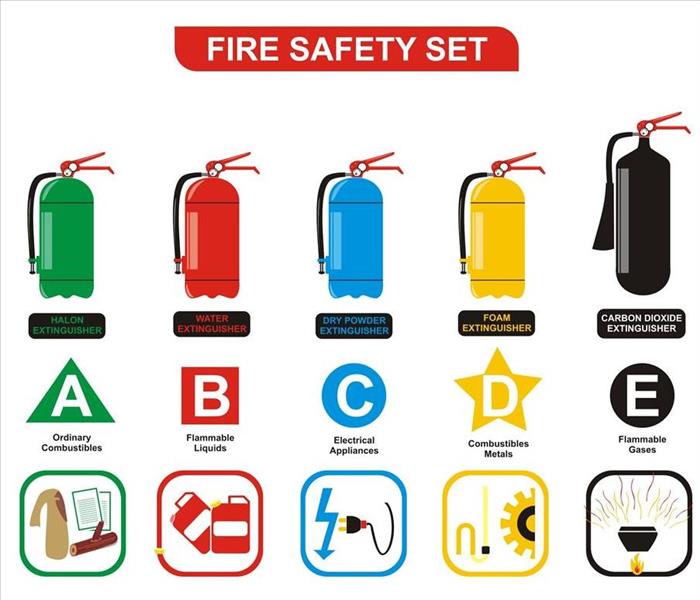 Often, you can purchase combination extinguisher that will effectively put out different types of fires.
Often, you can purchase combination extinguisher that will effectively put out different types of fires.
Extinguishers: Three Things You Should Know
A fire extinguisher in your home in Plant City, FL can be an effective way to keep you and your home safe. However, there are a variety of things that are helpful to know about extinguishers to ensure they can be used quickly and effectively.
1. The Type of Extinguishers in Your Home
Different types of extinguishers exist, and it’s helpful to do some research before placing one in a location within your home. For example, Type B extinguisher would help in the event of a kitchen fire caused by grease, whereas a Class A extinguisher can stifle fires that use wood as fuel. Often, you can purchase combination extinguisher that will effectively put out different types of fires.
2. The Location of the Extinguishers
Just having a fire extinguisher in your home isn’t enough to prevent a fire if the location of the extinguisher is not convenient. It’s often important to place extinguishers in areas such as kitchens and laundry rooms since these areas are common places for fires to occur. Additionally, it’s important to make sure that the extinguishers are within reach so you can access them quickly if needed.
3. How To Use the Extinguisher
In the event of a fire, it’s often helpful to know how to use an extinguisher quickly and correctly. Though extinguishers are labeled clearly with directions, it can save you time if you already know the appropriate steps to take. The term P.A.S.S. (pull, aim, squeeze, sweep) is a common acronym that is used to give people an easy way to remember the key steps to take when using an extinguisher.
Making sure you have the right types of fire extinguisher in your home, putting extinguishers in convenient locations and knowing how to use an extinguisher can be incredibly help if a fire occurs. If your home has been impacted by a fire, you may want to consider working with fire damage restoration experts.



 24/7 Emergency Service
24/7 Emergency Service








